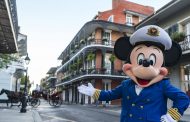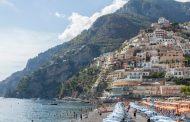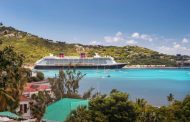The first part of the journey is to leave the saltwater on the Atlantic side of the canal. To do that we have to slide our 970+ foot x106 foot ship into a space 1000 feet by 110 feet. The Magic is a “Panamax” ship. It is the maximum length and width for any ship passing thru the canal. We had multiple tug boats escort us into and out of every lock.
Below we have one of our tug escorts, and shots from both port and starboard showing just how close we came to the sides of each lock. Note on the third picture the gigantic rubber bumper wheels at the corner of the lock entry. Several times we came into contact with those wheels.
To guide us thru the locks we had the further assistance of eight Mitsubishi electric traction engines with gigantic winches on the side. Each train, four on each side of the ship, controls two steel cables attached to the ship. The canal pilot instructs each of the eight train operators to adjust the 16 lines, keeping the ship centered in the lock. The train operators respond to each instruction by ringing their bell to let the pilot know that they have received the command. The ship powers itself into the lock, but the trains help to stop it when it gets in. Below you see one of the engines on a roundabout, followed by a shot of the Disney photographers who transited the canal on foot and in cars to get photos from outside of the ship, and another shot of the process from Deck 4, starboard.
As you can see below, the port side of deck 4 was almost empty, and even on the “crowded” starboard side it was easy to find a space. The White building behind Beci is the Gatun Locks control center.
We were the second ship thru the locks in the morning, behind the Nuclear Submarine. Behind us there was a long line of container ships waiting for their turn. About 40 ships make the crossing every day, at a cost of between $75,000 and $400,000. Cruise ships are at the expensive end of that scale, and we were right at the top – $400K – or in the range of $200 per person.
















